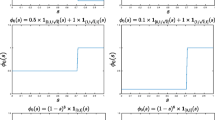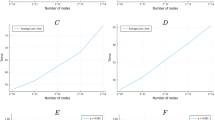Abstract
The classic Hegselmann-Krause (HK) model for opinion dynamics consists of a set of agents on the real line, each one instructed to move, at every time step, to the mass center of the agents within a fixed distance R. In this work, we investigate the effects of noise in the continuous-time version of the model as described by its mean-field Fokker-Planck equation. In the presence of a finite number of agents, the system exhibits a phase transition from order to disorder as the noise increases. We introduce an order parameter to track the phase transition and resolve the corresponding phase diagram. The system undergoes a phase transition for small R but none for larger R. Based on the stability analysis of the mean-field equation, we derive the existence of a forbidden zone for the disordered phase to emerge. We also provide a theoretical explanation for the well-known 2R conjecture, which states that, for a random initial distribution in a fixed interval, the final configuration consists of clusters separated by a distance of roughly 2R. Our theoretical analysis confirms previous simulations and predicts properties of the noisy HK model in higher dimension.






Similar content being viewed by others
References
Axelrod, R.M.: The Evolution of Cooperation. Basic books, New York (2006)
Bhattacharyya, A., Braverman, M., Chazelle, B., Nguyen, H. L.: On the convergence of the Hegselmann-Krause system. In Proceedings of the 4th conference on Innovations in Theoretical Computer Science, pp. 61–66. ACM, New York (2013)
Blondel, V. D., Hendrickx, J. M., Tsitsiklis, J. N.: On the 2r conjecture for multi-agent systems. In Control Conference (ECC), 2007 European, IEEE, pp. 874–881 (2007)
Blondel, V.D., Hendrickx, J.M., Tsitsiklis, J.N.: On Krause’s multi-agent consensus model with state-dependent connectivity. IEEE Trans. Autom. Control 54(11), 2586–2597 (2009)
Castellano, C., Fortunato, S., Loreto, V.: Statistical physics of social dynamics. Rev. Mod. Phys. 81(2), 591 (2009)
Chazelle, B.: The total s-energy of a multiagent system. SIAM J. Control Optim. 49(4), 1680–1706 (2011)
Chazelle, B.: An algorithmic approach to collective behavior. J. Stat. Phys. 158, 514–548 (2015)
Chazelle, B.: Diffusive influence systems. SIAM J. Comput. 44(5), 1403–1442 (2015)
Chazelle, B., Jiu, Q., Li, Q., Wang, C.: Well-posedness of the limiting equation of a noisy consensus model in opinion dynamics. arXiv preprint arXiv:1510.06487 (2015)
Chazelle, B., and Wang, C.: Inertial Hegselmann-Krause systems. In Proceedings of the IEEE American Control Conference (ACC) , pp. 1936–1941. (2016)
Deffuant, G., Neau, D., Amblard, F., Weisbuch, G.: Mixing beliefs among interacting agents. Adv. Complex Syst. 3, 87–98 (2000)
Easley, D., Kleinberg, J.: Networks, Crowds, and Markets: Reasoning About a Highly Connected World. Cambridge University Press, Cambridge, UK (2010)
Fornberg, B.: A Practical Guide to Pseudospectral Methods, vol. 1. Cambridge University Press, Cambridge, UK (1998)
Fortunato, S.: On the consensus threshold for the opinion dynamics of Krause-Hegselmann. Int. J. Mod. Phys. C 16(02), 259–270 (2005)
Garnier, J., Papanicolaou, G., Yang, T.: Consensus convergence with stochastic effects. CoRR abs/1508.07313 (2015)
Hendrickx, J., Blondel, V.: Convergence of different linear and non-linear Vicsek models. In Proc. 17th Int. Symp. Math. Theory Networks Syst. (MTNS 2006), pp. 1229–1240. (2006)
Jabin, P.-E., Motsch, S.: Clustering and asymptotic behavior in opinion formation. J. Differ. Equ. 257(11), 4165–4187 (2014)
Jadbabaie, A., Lin, J., Morse, A.S.: Coordination of groups of mobile autonomous agents using nearest neighbor rules. IEEE Trans. Autom. Control 48, 988–1001 (2003)
Jiang, K., Wang, C., Huang, Y., Zhang, P.: Discovery of new metastable patterns in diblock copolymers. Commun. Computat. Phys. 14: 443–460 (2013)
Kurz, S.: Optimal control of the freezing time in the Hegselmann-Krause dynamics. J. Differ. Equ. Appl. 21(8), 633–648 (2015)
Lorenz, J.: A stabilization theorem for dynamics of continuous opinions. Phys. A 355(1), 217–223 (2005)
Lorenz, J.: Consensus strikes back in the Hegselmann-Krause model of continuous opinion dynamics under bounded confidence. J. Artif. Soc. Soc. Simul. 9(1), 8 (2006)
Martínez, S., Bullo, F., Cortés, J., Frazzoli, E.: On synchronous robotic networks — part II: time complexity of rendezvous and deployment algorithms. IEEE Trans. Autom. Control 52(12), 2214–2226 (2007)
Martinsson, A.: An improved energy argument for the Hegselmann–Krause model. J. Differ. Equ. Appl, 1–6 (2015)
Mohajer, S., Touri, B.: On convergence rate of scalar Hegselmann-Krause dynamics. In Proceedings of the IEEE American Control Conference (ACC) (2013)
Moreau, L.: Stability of multiagent systems with time-dependent communication links. IEEE Trans. Autom. Control 50(2), 169–182 (2005)
Motsch, S., Tadmor, E.: Heterophilious dynamics enhances consensus. SIAM Rev. 56(4), 577–621 (2014)
Norris, J.R.: Markov Chains. Cambridge University Press, Cambridge, UK (1998)
Pineda, M., Toral, R., Hernández-García, E.: The noisy Hegselmann-Krause model for opinion dynamics. Eur. Phys. J. B 86(12), 1–10 (2013)
Touri, B., Nedić, A.: Discrete-time opinion dynamics. In 2011 Conference Record of the Forty-Fifth Asilomar Conference on Signals, Systems and Computers (ASILOMAR) (2011)
Wedin, E., Hegarty, P.: A quadratic lower bound for the convergence rate in the one-dimensional Hegselmann-Krause bounded confidence dynamics. Discret. Comput. Geom. 53(2), 478–486 (2015)
Acknowledgements
We wish to thank the anonymous referees for many useful comments and suggestions. Bernard Chazelle’s work is supported in part by NSF Grants CCF-0832797, CCF-0963825, and CCF-1016250; Weinan E’s work is supported by DOE grant DE-SC0009248 and ONR grant N00014-13-1-0338; Qianxiao Li’s work is supported by Agency for Science, Technology and Research, Singapore.
Author information
Authors and Affiliations
Corresponding author
Rights and permissions
About this article
Cite this article
Wang, C., Li, Q., E, W. et al. Noisy Hegselmann-Krause Systems: Phase Transition and the 2R-Conjecture. J Stat Phys 166, 1209–1225 (2017). https://doi.org/10.1007/s10955-017-1718-x
Received:
Accepted:
Published:
Issue Date:
DOI: https://doi.org/10.1007/s10955-017-1718-x




